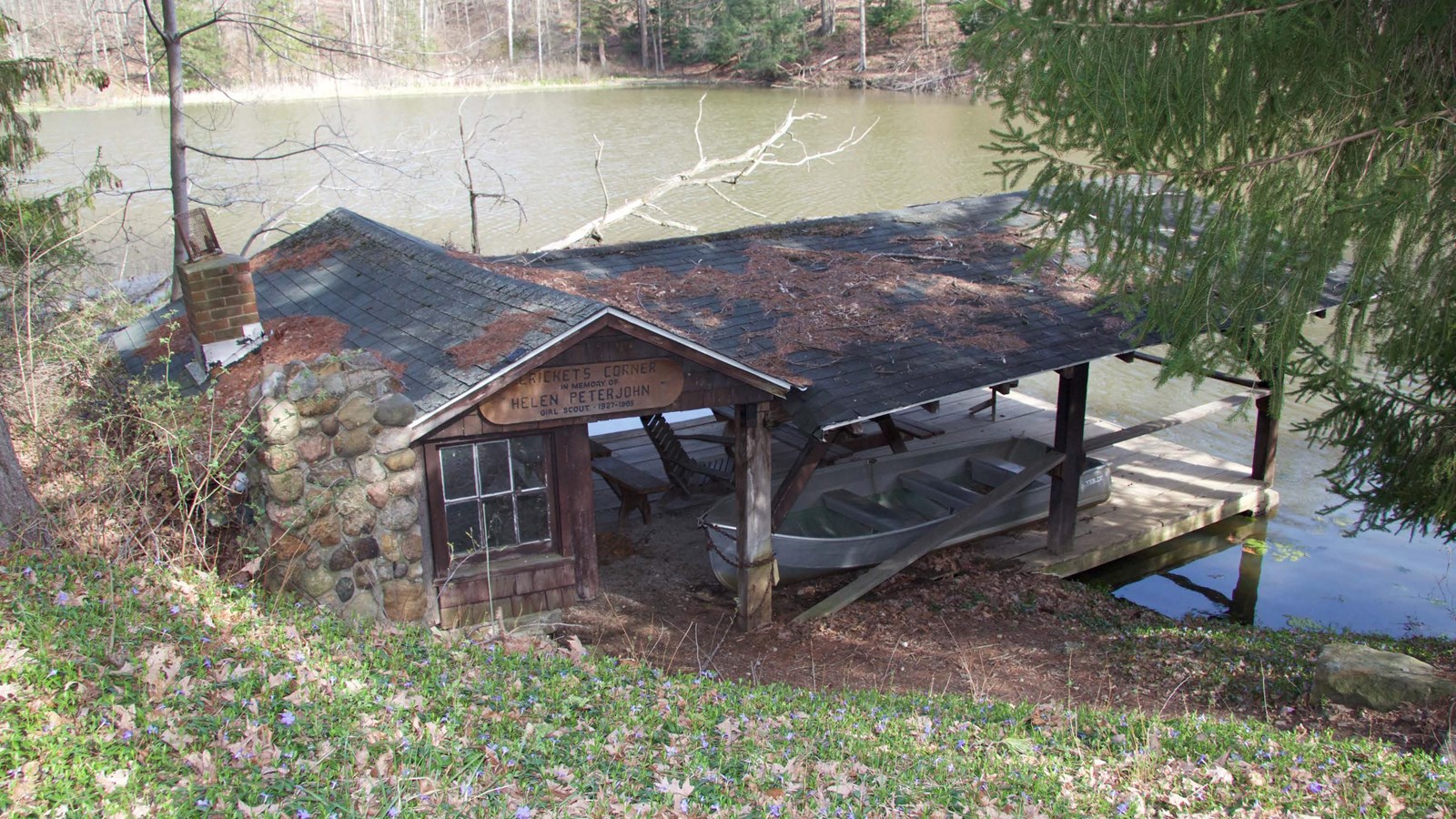Last updated: October 28, 2021
Place
Camp Crowell Hilaka Historic District

Photograph by Marcia E. Moll and Richard J. Sicha, Courtesy of the Ohio State Historic Preservation
Historical/Interpretive Information/Exhibits, Information Kiosk/Bulletin Board, Trailhead
Camp Crowell Hilaka Historic District is a 336-acre tract of land located in the western portion of Richfield Township, Ohio. It served as a Girl Scout Camp from 1937-2011. It is also significant for its association with the Cleveland Girl Scout Council which was an early leader in racial integration and religious inclusion, regardless of the socioeconomic background of its scouts. The Camp Crowell Hilaka property includes: 243 acres accumulated by James B. Kirby and sold to the Cleveland Girl Scout Council in 1937, which became Camp Julia Crowell; and 93 adjoining acres to the north sold by the Neal family to the Cleveland Girl Scout Council in 1957, which became Camp Hilaka. Over time, the combined camps became commonly referred to as Camp Crowell Hilaka. The combined acres reflects the same boundaries of the current public park, Richfield Heritage Preserve.
The Girl Scout Council purchased not only the land, but the collection of buildings of the Kirby and Neal families as well, in turn converting them all to Girl Scout camp functions and adding new facilities to accommodate the thousands of girls who used the camp annually for day, overnight, weekend, or summer resident camping.
While private camps for boys began to appear sporadically in New England in the 1870s and 1880s, the trend occurred later for private camps for girls. Accepted standards of behavior for Victorian era girls focused on the home, with the expectation that girls would learn to become wives and hostesses and manage a household with children. By the turn of the twentieth century, increasing educational attainment, the opening of employment opportunities in offices and stores, the evolution of women’s clothing to allow more freedom of movement, and the growth of outdoor activities for women such as cycling were all manifestations of the expanding role of women and girls in society.
At the turn of the 20th century, American Juliette Gordon Low, a descendent of the prominent Kinzie family of Chicago, lived in Great Britain. In 1911, she met retired British army officer Robert Baden-Powell, who had recently founded both the Boy Scouts and Girl Guides in that country. Juliette Low formed and led several Girl Guide troops in Great Britain, and with Baden-Powell’s encouragement, founded the Girl Guides national organization in America when she returned to Savannah, Georgia, in early 1912. News of the organization spread quickly, and also in 1912 the first troop of girls organized in Cuyahoga County in the community of Bay Village. The national organization changed its name to Girl Scouts in 1913, and in 1914 the Pansy Troop organized as the first Girl Scout troop in the City of Cleveland.
The breadth of organized camping ideals made it possible for persons and organizations to envision organized camping as a component in a march toward a better society. Privileged, educated young women of the early 20th century were expected to contribute to the betterment of society through volunteerism or even in a career such as social service, education, or recreation. Responsibility and leadership, gained through camping, would provide women with key tools to shed the domestic norms of the Victorian period and actively participate in the broader society. This activism often exhibited itself in efforts to advance the reform agenda of the Progressive Movement, including women’s suffrage, improving conditions in poor, overcrowded urban neighborhoods, and the creation of professionalized organizations dedicated to the betterment of girls and young women, such as the Girl Scouts, Camp Fire, and the YWCA Girl Reserves.
Camp Julia Crowell became the Cleveland Council’s most versatile facility, offering day camping, overnight hikes, weekend camping, one-week camping, two-week summer camping sessions, and functioning as a training center for current and new adult camp leaders. The Girl Scouts also differentiated the camping experiences. One purpose of short camping excursions, such as weekend troop camping, was to have girls work on planning and skill training before the trip. At two-week resident summer camp, the purpose was to have girls learn skills while at camp, not beforehand. During summer resident camp, girls camped in tents only. During spring and fall, troops could stay in cabins or tents. In winter, camping stays were limited to winterized cabins/buildings. The ability to offer outdoor camping for a day, weekend, or two-week session – was integral to the mission of the Girl Scouts since the national organization’s founding in 1912 and the Cleveland Girl Scout Council’s establishment in 1922. Camp Crowell provided countless girls and young women the opportunity to experience the outdoors in an atmosphere of inclusion and positivity.
Girl Scout founder Juliette Low firmly believed that American girls needed to live active lives outside the home, where they could contribute to society as full citizens. Furthermore, camping provided the pathway to that goal, because it is “more than learning campcraft skills and how to live in the out-of-doors; it is truly a new way of life with new disciplines and new joys; . . . camping stretches a girl’s capacity, enlarges her adaptability to new situations, and challenges her to make Girl Scout ideals a living principle in her life.” For tens of thousands of Ohio girls, that outdoor camping experience happened at Camp Crowell Hilaka.
